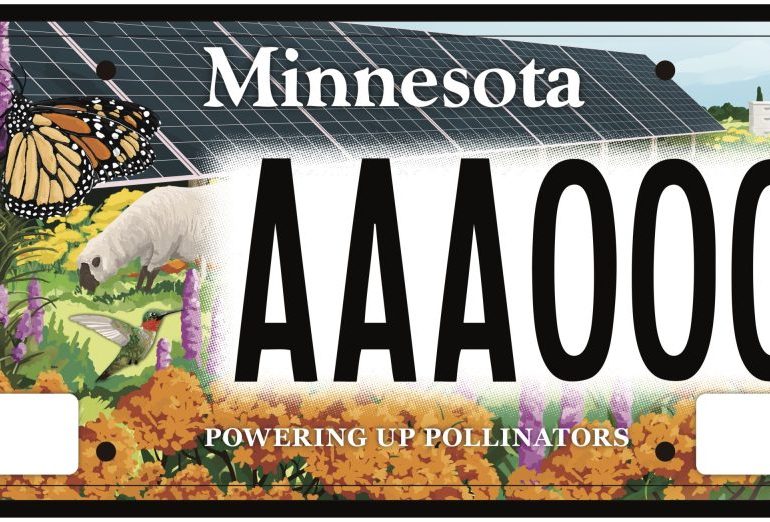The following commentary was written by Arlo Hark of Cannon Valley Graziers in Minnesota. See our commentary guidelines for more information.
In 2016, a coalition of energy, agriculture, and conservation organizations worked together to pass the Pollinator-Friendly Solar Act, the nation’s first ground cover standard for solar facilities. Using seed mixtures which cost less than 0.1% of the overall project budget, the flexible and science-based standard established minimum requirements for solar site owners to implement in order to claim that solar projects “provide habitat beneficial to pollinators, songbirds, or game birds.”
The resulting program, managed by Minnesota’s Board of Water and Soil Resources (BWSR), has been successful with the state’s limited solar build out. For example, a longitudinal field study led by Argonne National Lab across 5 years (2018–2022) revealed how insect communities responded to newly established habitat on solar energy facilities in agricultural landscapes. The report, “If you build it, will they come? Insect community responses to habitat establishment at solar energy facilities in Minnesota,” revealed a 3-fold increase in overall pollinator abundance and a 20-fold increase in native bees such as bumblebees.
However, Minnesota recently passed ambitious renewable energy and carbon-free electricity requirements which will result in significantly more solar projects throughout the state and BWSR’s Habitat Friendly Utilities program has been operating without dedicated funding. You should be as concerned as I am about the risk of backlash from rural communities that will host these projects.
However, earlier this month, Representative Matt Norris and Senator Rob Kupec with a broad coalition of leading organizations from agriculture, conservation, and energy, introduced HF 5207/SF 5239, a new voluntary license plate that highlights the best of dual-use solar practices while also providing much needed funding for BWSR’s program.
For the past five years, my business, Cannon Valley Graziers, has been dedicated to advancing targeted grazing systems, known as solar grazing, to support the ecological stewardship of sites enrolled in the BWSR program. By integrating pollinator-friendly ecosystems and implementing grazing practices on solar sites, we not only generate clean electricity but also keep farmland in agricultural production, enhance soil health and water quality, expand habitat for keystone species, and foster rural employment opportunities.
Another organization from Greater Minnesota supporting Norris and Kupec’s legislation is Montevideo-based CURE. “With our work firmly grounded in benefitting rural places, CURE is greatly encouraged by the success of BWSR’s Habitat Friendly Utilities program,” said executive director Duane Ninneman. “It is important to establish a dedicated funding source for this program, particularly at this pivotal time in Minnesota’s energy transition. Pretty pictures can too easily get written off as unserious, but this license plate tells an important story about all the beauty and economic vitality we can build in rural places if we set our mind to it.”
It’s not just shepherds like me, or energy advocates like CURE, Audubon Minnesota recently issued an action alert to its members in support of the bill. “By prioritizing native plants at solar sites, Minnesota can meet critical clean energy goals while restoring pockets of lost habitat for pollinators and birds,” said Audubon’s Lindsay Brice.
And in part because of their requirement of pollinator-friendly ground cover for all their solar projects, Connexus Energy, Minnesota’s largest electric cooperative, recently became the first cooperative to named to Fast Company magazine’s prestigious Most Innovative Companies list.
The coalition of supporting organizations for HF 5207/SF 5239 also includes Monarch Joint Venture, American Farmland Trust, Great Plains Institute, Vote Solar, Natural Resource Services, Fresh Energy, Minnesota Farmers Union, Pollinate Minnesota, and Bare Honey. Clearly there is a win, win, win opportunity to be had here.
Use of prime farmland for solar is a perennially divisive and controversial topic here in Minnesota, but promoting adoption of farm- and conservation-friendly management practices and dual-use solar enjoys overwhelming support. I urge Minnesota legislators to send this bipartisan bill to the Governor’s desk this year.
Commentary: This license plate will strengthen solar’s social license in Minnesota is an article from Energy News Network, a nonprofit news service covering the clean energy transition. If you would like to support us please make a donation.
Leave a comment







